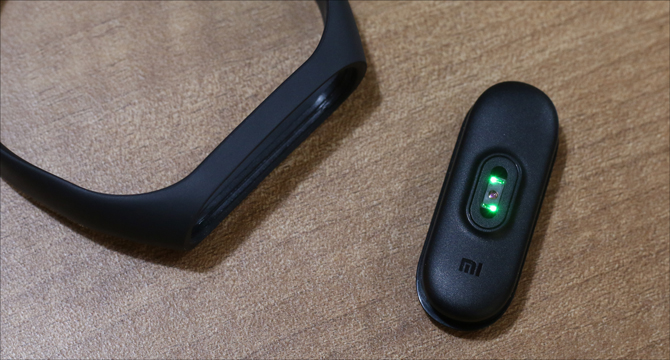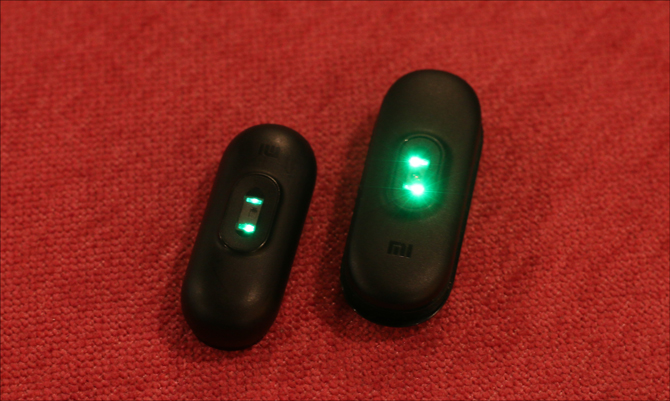Mi Band 3 is out for a while now and Xiaomi has aggressively marketed it as the best budget fitness tracker. Now, I don’t believe in the hype unless I test the products myself. Although Mi Band 3 does come with features like bigger display, touch controls, notifications, etc. Let’s see if it is really worth the upgrade from Mi Band 2. Let’s begin.
Read: How to control Android Camera with Mi Band
Mi Band 2 vs Mi Band 3
1. Appearance
At first glance, you can see some major design changes on the Mi Band 3. The newer generation Mi Band 3 is now a little bigger and has a curved glass (clear plastic) screen. Mi has also redesigned the strap and it offers a better quality strap than the Mi Band 2.
Mi band 2 was a simple tracker and only had one button, Mi band 3 has upgraded the hardware and replaced the button entirely with the capacitive touch interface. Although Mi Band 3 still has a concave dent where the button should have been to give users an idea of the potential button position.
The better display and a larger resolution on the Mi Band 3 allows for more information that can be displayed within the compact form factor.

2. Build Quality
Though a decent upgrade from the previous generation, Mi band 3 is made of the same ABS type plastic with a clear screen which feels like glass but scratches very easily. The curved glass with a redesigned strap fits snug on Mi Band 3 and gives it a seamless finish which is a noteworthy design component.
The strap is a silicone based band with a smooth surface finish and sits well on the wrist, it does build up the sweat in the crevice of the strap where the module sits. Even if you work out a lot that’s not a problem with any of the devices, you can just rinse both bands under a running tap.

3. WaterProofing
Mi Band 2 is IP67 certified product and complies with the standard, meaning you can dunk the band in 1m deep water for up to 30 minutes without any damage. Mi Band 3 has taken it up a level ahead and boasted of handling up to 5atm pressure under water.
If we talk about depth it comes around 50m below the surface of the water for the Mi Band 3. You can take your Mi Band 3 for a dive and not think twice about it. I couldn’t test this claim because I don’t live near water and swimming pools in my area aren’t that deep but I have been showering while wearing the bands and it has had no problems whatsoever.
4. Display
Mi Band 3 has evolved in almost every aspect when compared with the previous generation of Mi Bands. The most notable upgrade is the display. It has been upgraded to a 17.74mm display from the previous 10.16mm display screen. The resolution on Mi Band 3 is 128×80 which is double when compared with 72×40 on the Mi Band 2.

5. Battery
Mi Band 3 houses a 60% larger battery than the last gen Band 2. The number of upgrades like the larger display and the updated heart rate sensor requires more power and to offer the same battery life this decision was made. Charging the devices is not a hassle, both devices take around 3 hours to charge fully and I can just plug them while working with its proprietary charging adaptor.
Mi boasts of a 20*-days battery life but that is under test conditions while keeping activity to a minimum. I tested the claim by setting the heart rate monitor to take a reading at a one-minute interval. The Mi Band 3 lasted for an upwards to 36 hours. I am not disappointed considering the tiny battery that powers all these features lasted that long.
When I stopped monitoring my heart rate completely the battery back up improved significantly and I could use the juice for around 15 days without a hiccup on the Mi Band 3, while on the Mi Band 2 (one-year-old device), I tracked my steps and sleep every day and updated the data to the app and it lasted for around two weeks which is still impressive.

6. Heart Rate Sensor
Now I don’t think these budget fitness trackers can beat the accuracy levels of high-quality trackers like the Fitbit, Gramin, or the Apple Watch.
I tested the accuracy of the two bands with the Apple Watch. And all the three (Mi band 2,3, and Apple Watch) gave me different results. Apple Watch came the closest when I measured my heartbeat manually using the ‘two finger to the wrist’ method. Mi Band 2 gave me the most inaccurate reading. The Mi Band 3, however, came a close second and almost got the reading right with an error of about ±3bpm.
The weak sensor on the Mi Band 2 couldn’t even get the reading because of my hairy arms. Mi Band 3 has certainly paid attention to the criticism and upgraded the hardware.

7. Sleep Tracker
Sleep tracking is improved fairly on the Mi Band 3 when compared to the Mi Band 2 and I could see a visible difference while measuring the two data. I used both the bands while going to bed and sometimes woke up in the middle of the night multiple times to check the time and for a glass of water. Mi Band 3 registered it as the wake time but Mi Band assumed I was still sleeping.
Mi Bands track the sleep in two stages, Light and deep. I collected the data for the same night and both bands did start the sleep time when I actually fell asleep and woke up but the amount of deep sleep and light sleep ratio was different on the two. Check the images below to see for yourself.
Xiaomi has improved so many things on the Band 3 including the algorithms that it almost feels like an entirely new product rather than an upgrade.


What you can do on your Mi Band?
Mi Band 2 houses a button and you have to tap the button lightly to get the time, steps and heart rate. There is no long press option. To compensate this, the features are invoked automatically when you scroll to the item in the list.
Mi Band 3 has a capacitive touch screen which allows swipe actions and a tap and a long press feature. The band has multiple standalone functions which it can perform.
You can check the number of steps, invoke heart rate sensor, check weather details for the next three days, calculate exercise time and calories burned, see notifications, stopwatch, find your phone, and change the home screen on the Band.
The accompanying app Mi-Fit has some more features which you can set on the band. You can set alarms which would then vibrate your band to wake you up. You can set call notifications, which would buzz the band whenever you get a call on your Phone.
With the Mi Band 3, you can unlock your phone with just one swipe of your phone, this feature is not available on the Mi Band 2. You can easily find your band from the app but you can also find your Phone through the band. I think this backward compatibility is a nice feature which is a life saver for me.
| Features | Mi Band 3 | Mi Band 2 |
| Weight | 20g | 20g |
| Display Resolution | 128×80 | 72×40 |
| Display Size | 0.7 | 0.4 |
| Dimensions | 17.9×46.9x12mm | 15.7×40.3×10.5mm |
| Interface | Touch capacitive | Button |
| Battery | 110mAh | 70mAh |
| Battery backup | 20 days* | 20 days* |
| Waterproofing | 5ATM (50m) | IP67 |
| Connectivity | 4.2 BLE | 4.0 BLE |
| Price | $37 | $27 |
*tested under lab conditions with minimum interaction with the band (Xiaomi’s Claim).
Also Read: Use Mi Band to control music on your Android/TV
Final Thoughts: Mi Band 2 vs Mi Band 3
If you have an active lifestyle but need something to cost-effective to monitor the activities, Mi Band 3 is a good choice. Although I wouldn’t rely on the data too much as it is generated with a less than precise hardware and interpreted with the algorithms that are constantly debugged. It is suitable for normal day to day activities and light activity tracking. What do you think about the Mi Band 3, let me know in the comments?